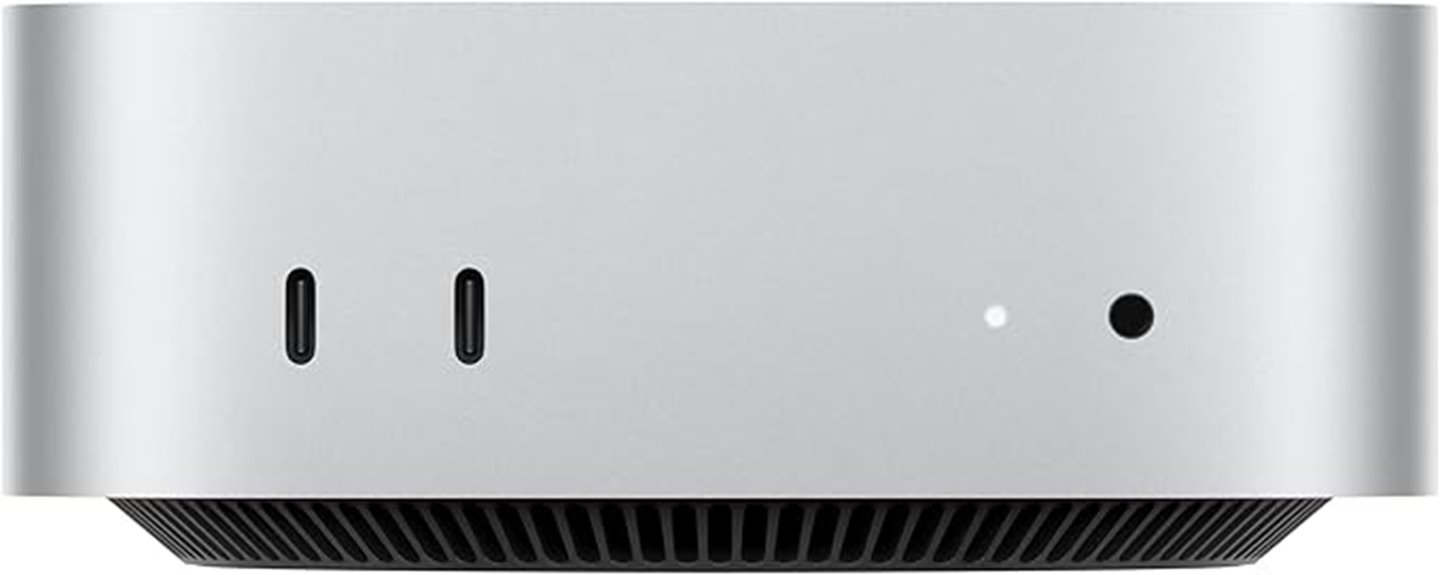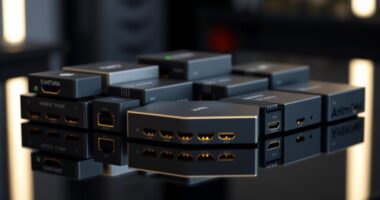If you’re looking for the best Mac Studios for machine learning in 2025, I’d recommend considering models with the latest M4 or M4 Pro chips, as they offer powerful CPUs, advanced GPUs, and neural engines for optimized AI tasks. Upgrading RAM and storage further boosts performance for large datasets. These configurations provide a strong balance of power, efficiency, and precision. Stay with me, and you’ll discover the key factors to choose the perfect setup.
Key Takeaways
- Mac mini with M4 Pro offers the best balance of CPU, GPU, and RAM for demanding ML workloads.
- Higher core counts and larger RAM configurations (up to 64GB) significantly boost deep learning performance.
- Hardware acceleration features and Neural Engine optimize AI training and inference efficiency.
- Models with larger SSDs and Thunderbolt 4/5 support facilitate faster data transfer and storage handling.
- Selecting the right connectivity and GPU options ensures scalability and future-proofing for ML tasks.
Apple 2024 Mac mini Desktop Computer with M4 Chip

If you’re looking for a compact yet powerful machine learning workstation, the Apple 2024 Mac mini with M4 chip is an excellent choice. Its 10-core CPU, 10-core GPU, and 16-core Neural Engine deliver fast, efficient processing for demanding ML tasks. The small form factor—just 5×5 inches—fits easily next to your monitor, while supporting up to three high-resolution displays. With 24GB of unified memory (upgradeable to 32GB) and fast SSD storage, it handles large datasets seamlessly. Plus, its versatile ports, Wi-Fi 6E, and robust media capabilities make it ideal for integrating with your existing setup, all while supporting Apple’s sustainability goals.
Best For: professionals seeking a compact yet powerful desktop for advanced machine learning, content creation, and seamless Apple ecosystem integration.
Pros:
- Compact size fits easily next to monitors and in tight spaces
- Powerful M4 chip with 10-core CPU, GPU, and Neural Engine for demanding tasks
- Supports up to three high-resolution displays and fast data transfer with versatile ports
Cons:
- Limited upgradeability beyond initial RAM and storage options
- Higher price point compared to some traditional mini desktops with similar specs
- No dedicated GPU options, which may impact specialized high-end graphical workloads
Apple 2024 Mac mini Desktop Computer with M4 Pro chip

The Apple 2024 Mac mini with the M4 Pro chip stands out as an ideal choice for machine learning enthusiasts who need powerful, compact hardware. Its small 5×5-inch design packs a 12-core CPU, 16-core GPU, and 16-core Neural Engine, delivering exceptional performance for demanding tasks. With up to 64GB of unified memory and multiple storage options, it handles complex models and large datasets effortlessly. Connectivity is versatile, supporting three displays, Thunderbolt 5, HDMI, and high-speed Ethernet. Seamlessly integrated with macOS and Apple’s ecosystem, it offers reliable, high-performance computing in a tiny footprint—perfect for boosting your machine learning workflows.
Best For: machine learning enthusiasts and developers seeking a compact, high-performance desktop for complex models and large datasets.
Pros:
- Compact 5×5-inch design fits easily into any workspace or setup
- Powerful hardware with 12-core CPU, 16-core GPU, and 16-core Neural Engine for demanding tasks
- Supports multiple high-resolution displays and fast connectivity options like Thunderbolt 5 and 10Gb Ethernet
Cons:
- Limited upgradeability due to integrated Apple silicon architecture
- Higher initial cost compared to less powerful or traditional mini PCs
- May require external peripherals for comprehensive workstation setup
Apple Mac mini Desktop Computer with M4 Chip (512GB SSD, 16GB RAM)

Designed for professionals seeking a compact yet powerful machine learning setup, the Apple Mac mini with M4 chip offers impressive performance in a tiny footprint. Its 5×5-inch size and lightweight design make it easy to place anywhere, while the M4’s 10-core CPU and GPU deliver robust processing power. The 16-core Neural Engine and hardware-accelerated media engine accelerate AI workloads and media tasks. With 16GB of unified memory and 512GB SSD storage, it handles complex models and large datasets smoothly. Supports multiple high-resolution displays and seamless connectivity, all while maintaining Apple’s eco-friendly commitment. This mini powerhouse is perfect for those needing performance without sacrificing space.
Best For: professionals and researchers seeking a compact yet powerful machine learning setup capable of handling complex models and large datasets with ease.
Pros:
- Compact size and lightweight design for easy placement anywhere
- Powerful M4 chip with 10-core CPU and GPU for robust processing
- Supports multiple high-resolution displays and seamless connectivity
Cons:
- Limited to 16GB of unified memory (configurable to 24GB/32GB) which may be restrictive for very large datasets
- Premium price point for a mini desktop that may be costly compared to other compact options
- Limited upgradeability post-purchase due to integrated components
Apple Mac mini Desktop Computer with M4 Chip (256GB SSD, 16GB RAM)

For machine learning professionals seeking a compact yet powerful desktop, the Apple Mac mini with the M4 chip stands out as an ideal choice. Its small five-by-five-inch design easily fits next to monitors, making it perfect for tight workspaces. Powered by the M4 chip’s 10-core CPU, 10-core GPU, and 16-core Neural Engine, it delivers impressive performance for demanding tasks. With 16GB of unified memory and a 256GB SSD, it supports smooth multitasking and quick data access. The Mac mini’s versatile connectivity, including Thunderbolt 4, USB-C, HDMI, and Wi-Fi 6E, ensures seamless integration into any workflow.
Best For: machine learning professionals and creative users seeking a compact yet powerful desktop with seamless Apple ecosystem integration.
Pros:
- Compact size fits easily next to monitors, ideal for tight workspaces
- Powered by the M4 chip with a 10-core CPU and GPU for high performance
- Supports multiple high-resolution displays and fast connectivity options
Cons:
- Limited storage options starting at 256GB may require external drives for large datasets
- No dedicated GPU options, which could affect certain graphics-intensive tasks
- Higher configurations (like 32GB RAM or larger SSDs) come at additional cost
Factors to Consider When Choosing a Mac Studio for Machine Learning

When selecting a Mac Studio for machine learning, I consider several key factors to guarantee ideal performance. These include processing power, GPU capabilities, memory capacity, storage options, and connectivity features. Focusing on these points helps me find a setup that meets my specific computational and workflow needs.
Processing Power Needs
Choosing the right Mac Studio for machine learning hinges heavily on processing power, as it directly affects how quickly and efficiently you can train complex models. Higher CPU cores accelerate data processing and reduce training times, making it essential to select a model with ample processing capacity. A robust neural engine or dedicated hardware acceleration can further cut down training periods for deep learning tasks. Handling large datasets demands high throughput and memory bandwidth, so systems with upgraded processors or additional GPU resources are beneficial. The ability to scale processing power ensures smoother workflows and faster experimentation. When evaluating options, prioritize models that offer powerful CPUs, multiple cores, and improved hardware acceleration to meet the demanding needs of machine learning workloads.
GPU Capabilities
Processing power is vital for machine learning, but GPU capabilities often determine how well a Mac Studio can handle the heavy parallel processing tasks involved. The GPU’s core count and architecture are key, impacting how efficiently it manages large models and datasets. Hardware-accelerated ray tracing and media engines can boost performance in applications involving graphics or video processing, which sometimes overlaps with ML workflows. Larger GPU memory allows for handling bigger models without frequent data swapping, improving training speed. Support for high-bandwidth interfaces like Thunderbolt 4 or 5 guarantees faster data transfer between the GPU and storage, reducing bottlenecks. Compatibility with features like hardware-accelerated decoding and encoding also plays a vital role, especially when working with multimedia data. These factors collectively influence a Mac Studio’s ML performance.
Memory Capacity
Memory capacity is a critical factor that directly impacts a Mac Studio’s ability to handle large datasets and complex machine learning models. With higher RAM, I can process bigger datasets without slowing down or relying heavily on disk swapping, which hampers performance. Many Mac mini models start with 24GB of unified memory, but upgrading to 32GB, 48GB, or even 64GB makes a noticeable difference, especially for demanding tasks. Sufficient RAM reduces bottlenecks by allowing faster data access and transfer, particularly with high memory bandwidth, like the 120GB/s in M4 chips. Choosing a Mac Studio with upgrade options also future-proofs my setup, so I won’t need to replace hardware as datasets grow and models become more complex. Memory capacity truly determines how efficiently I can train and run large-scale machine learning workflows.
Storage Options
When selecting a Mac Studio for machine learning, storage options play a essential role in guaranteeing smooth workflows and scalability. Larger SSDs, like 2TB or 4TB, enable you to handle extensive datasets and models locally without constant data transfers. Upgrading to higher storage configurations helps prevent bottlenecks, especially during intensive training and inference tasks. Ample storage ensures faster read/write speeds, directly boosting overall performance and efficiency. It also allows you to store multiple large models, datasets, and essential software tools needed for complex projects. Considering future storage needs is indispensable since machine learning projects tend to grow in data size over time. By choosing appropriate storage options now, you set a foundation for seamless expansion and sustained performance in your machine learning endeavors.
Connectivity Features
Choosing the right connectivity features on a Mac Studio is essential for optimizing your machine learning setup. You’ll want enough Thunderbolt 4 or 5 ports to connect multiple external devices, such as GPUs, storage drives, and peripherals, ensuring smooth data flow. Compatibility with high-speed standards like USB 4 and DisplayPort 2.1 is crucial for rapid data transfer and supporting high-resolution displays needed for data visualization. Reliable network connectivity is imperative, so look for Gigabit or 10Gb Ethernet options to handle large dataset transfers and cloud integration efficiently. Additionally, multiple video outputs, including HDMI and native DisplayPort support, enable connecting several high-res monitors. Wireless features like Wi-Fi 6E and Bluetooth 5.3 facilitate seamless integration with other devices, making your workflow more flexible and efficient.
Budget Considerations
While it’s tempting to go all-in on the most powerful Mac Studio for machine learning, your budget often plays a key role in shaping the right choice. Higher-priced models with more RAM and larger storage typically deliver better performance, especially for demanding ML tasks. Balancing the need for a robust GPU, like the 16-core, with your budget constraints is essential for efficient processing. Investing in models with extra memory, such as 48GB or 64GB, can speed up training but will increase costs. Consider whether the long-term benefits of hardware upgrades outweigh initial expenses, especially if you plan to expand workloads. Your budget may also influence decisions about cores, SSD size, or connectivity features critical for intensive ML applications.
Frequently Asked Questions
How Do Mac Studio Models Compare for Large-Scale ML Workloads?
I find that the latest Mac Studio models excel in handling large-scale machine learning workloads. The M2 Ultra chip offers remarkable processing power and efficiency, making it ideal for intensive tasks. With its high RAM capacity and advanced GPU, I can run complex models smoothly. Overall, Mac Studios are a strong choice for ML, providing the performance and precision needed for demanding projects.
What Are the Upgrade Options for Mac Studios in 2025?
In 2025, Mac Studios offer several upgrade options, including increased RAM, faster SSD storage, and enhanced GPU configurations. I can also customize the processor to boost performance for demanding machine learning tasks. Apple’s flexible upgrade paths make it easier for me to optimize my setup as my workload grows. If you’re planning to upgrade, I recommend considering these options to maximize power and efficiency for your projects.
How Does Thermal Management Affect ML Performance on Mac Studios?
Thermal management is vital for ML performance on Mac Studios because it prevents overheating, which can throttle the CPU and GPU, reducing efficiency. When the system stays cool, it maintains peak performance longer, allowing complex ML tasks to run smoothly without interruptions. I always pay attention to proper ventilation and cooling options, ensuring my Mac Studio stays in excellent condition for demanding machine learning workloads.
Are Mac Studios Compatible With the Latest ML Software Frameworks?
Yes, Mac Studios are compatible with the latest machine learning software frameworks. I’ve found that many popular tools like TensorFlow, PyTorch, and Apple’s Core ML run smoothly on them, especially with the latest macOS updates. I appreciate how Apple’s hardware and software integration optimizes ML workflows, making it easier for me to develop and deploy models efficiently. Overall, Mac Studios are a solid choice for machine learning tasks in 2025.
What Security Features Enhance Data Protection During ML Tasks?
When I work on ML tasks, I rely on robust security features to keep my data safe. Apple’s T2 chip offers hardware encryption, while FileVault encrypts my entire disk, adding a silent shield. Gatekeeper ensures only trusted software runs, and macOS’s sandboxing isolates apps. These features act like a secure vault, quietly safeguarding my sensitive data and maintaining integrity without interrupting my workflow.
Conclusion
If you’re serious about machine learning, choosing the right Mac Studio can make all the difference. Did you know that Apple’s M4 Pro chip offers up to 40% faster processing than previous models? That’s a game-changer for handling complex datasets. Whether you opt for the M4 or M4 Pro, investing in a powerful Mac Studio means you’ll boost your productivity and stay ahead in AI innovation. Ready to elevate your machine learning game?








